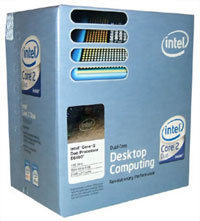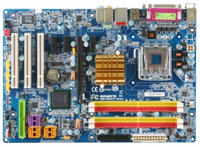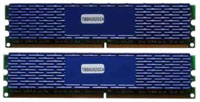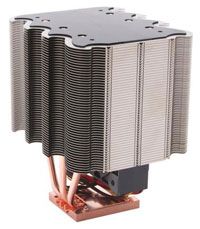Midrange Overclocking Configuration
The final category we have to talk about involves everyone's favorite topic: overclocking. We have shown in
recent articles that certain CPUs can outperform processors that cost six times as much once you add in overclocking. A lot of people also like the thought of getting "something for nothing," so we will conclude this Buyer's Guide with some upgrades intended to help you get the most out of your overclocking endeavors.
| Intel Mid-Range Overclocking System |
| Hardware |
Component |
Price |
Rebates |
| Processor |
Intel Core 2 Duo E6400 (2.13GHz 2MB Shared) - Retail |
$223 |
|
| Heatsink |
Tuniq Tower 120 |
$55 |
|
| Motherboard |
Gigabyte GA-965P-DS3 (P965 775) |
$138 |
|
| Memory |
Super Talent 2x1GB DDR2-800 (T800UX2GC4) |
$268 |
|
| Video Card |
eVGA GeForce 7600GT 256MB (256-P2-N550 -T2) |
$131 |
|
| Hard Drive |
Seagate 320GB SATA 3.0Gbps 7200RPM 16MB (Barracuda 7200.10) |
$90 |
|
| Optical Drive |
LG Black 18X DVD+R (GSAH22N-BK) |
$36 |
|
| Case |
Antec Solution SLK3000-B |
$76 |
|
| Power Supply |
OCZ GameXStream 700W (OCZ700GXSSLI) |
137 |
|
| Display |
Acer AL2016W 20" 8ms (1680x1050) |
$233 |
|
| Speakers |
Logitech X-530 5.1 70W Speakers |
$74 |
|
| Keyboard and Mouse |
Microsoft Comfort Curve 2000 B2L-00047 |
$28 |
|
| Operating System |
Windows XP MCE 2005 (with Vista coupon) |
$115 |
|
| Bottom Line |
|
$1604 |
$1604 |
 |
So far in this guide, AMD platforms have been a reasonable alternative to Intel's Core 2 Duo platform. They may not be faster in many cases, but at the lower end of the dual core spectrum the price/performance is nearly identical when comparing Athlon X2 and Core 2 Duo. Once you add in overclocking, however, there's no way that we would currently recommend AMD over Intel. There are still some AMD chips that can achieve impressive overclocks - one of our editors for instance is running an Athlon X2 4000+ (2.0GHz 1MB cache stock) at 3.08 GHz - but with many Core 2 Duo overclocks reaching 3.5 GHz and higher AMD is not currently able to match that level of performance, short of resorting to phase change cooling.
 |
Besides the processor, there are several critical components that can help increase overclocking potential as well as providing improved stability. First of course is the motherboard, which almost goes without saying. A great chipset alone can't provide for excellent overclocking, and at the same time the world's best BIOS programmers can't overcome chipset limitations. When you get a great chipset with an excellent motherboard design and the proper BIOS, however, the results can be extremely impressive. There are motherboards that overclock better than Gigabyte's GA-965P-DS3, but with the latest BIOS update and the price of under $150 it is very difficult to beat the DS3. The ASUS P5B-E we mentioned previously is a close second; the DS3 costs a bit less and overclocks a bit further, while the ASUS has a few more features.
 |
Next on the upgrade requirements for overclocking has to be memory. You can get some very respectable overclocks using just about any DDR2-800 memory, but if you want to push into the 500MHz bus speed overclocks and beyond, you'll need memory that can function at DDR2-1000 and higher. As this is a midrange guide, we didn't want to go to extreme on the memory side of things, but the Super Talent memory we mentioned previously can easily reach DDR2-1000 at 2.2V and we feel that's sufficient given our other components. Using a 1:1 memory:bus ratio (which is typically optimal for overclocking), DDR2-1000 means you can run a 500MHz bus. You may have noticed that we didn't select an E6300 processor, and the reason is that we don't want the RAM and bus speed to be the limiting factors. An E6300 with a 500MHz bus would be running at 3.5 GHz, and while that's certainly an impressive overclock we prefer the 8X multiplier of the E6400. It is doubtful that you will be able to run most E6400 chips at 4.0GHz, but hitting somewhere around 3.6-3.7 GHz isn't uncommon.
 |
The last two items that are important when looking at maximum overclocking are CPU/system cooling and the power supply. The stock Intel heatsink performs quite well, but it's still not able to match the cooling prowess of the better aftermarket solutions. As we showed in our recent article, the
Tuniq Tower 120 was able to dramatically lower processor temperatures, and it also improved overclocking headroom by about 200MHz. It manages to do this without generating a lot of noise, and for a cost of about $60 it provides a far better long-term overclocking solution than the stock heatsink. In order to overclock most CPUs beyond a certain point, it is necessary to increase the processor voltage. This in turn increases the heat generated by the CPU, so adequate cooling becomes even more critical. Large aftermarket heatsinks like the Tuniq Tower 120 may be a bit more difficult to install, but they are still highly recommended for anyone looking to push their CPU to the limit.
 |
Increasing processor and memory voltages naturally puts a larger strain on the power supply. Several of the other editors have burned through quite a few power supplies during overclocking attempts, especially at the more extreme end of the equation. When we looked at upgrading the power supply to something that would be suitable for intense overclocking, we found that most of the 500W to 600W power supplies really didn't cost much less than the 700W PSU that we selected. The Fortron Source FX700-GLN is essentially the same power supply as the OCZ GameXStream 700W, and it's priced about the same. However, the Fortron Source comes with a two-year warranty while OCZ has a three-year warranty, so the choice is pretty clear.
We stuck with a pretty average GPU on our overclocking system - faster than the base 7600GS, but a 7600GT is by no means a graphics powerhouse these days. NVIDIA cards typically overclock better than AMD offerings, but the 7600GT is already factory overclocked and probably can't get much faster. If you want to get a high-performance GPU with more overclocking headroom, the GeForce 8800 GTS cards appear to be the best bet right now. They're already fast at stock speeds, but overclocking has helped quite a few people reach near 8800 GTX performance levels at 2/3 the cost. As always, your mileage may vary, and we would tend to be a bit more cautious with overclocking GPUs as opposed to CPUs.
So what's the bottom line when it comes to overclocking? For about $300 more, you can most likely get a Core 2 Duo E6400 to run twice as fast as the stock E6300. Individual results will of course vary, as no two processors are identical, but we are reasonably confident that knowledgeable overclockers will be able to hit 3.6 GHz or more with this particular configuration. If you wanted to stick with the basic Intel configuration we listed and simply overclock that, you could probably hit 2.8 GHz before running into the limitations of the memory and motherboard, but you would also end up with a processor that was running somewhat warm. Before you go out and jump on the configuration we just listed, however, keep in mind that the Core 2 Duo E4300 will be available shortly with a lower price, and with the lower base front side bus speed and a 9X multiplier it should be able to reach 9x400 (3.6 GHz) simply by adding a better aftermarket heatsink.
Conclusion
We've covered no less than five potential system builds in this Midrange Buyer's Guide, and still we haven't covered every possibility. However, with the information we've provided, you should now have enough information to get started building your own ideal midrange computer. As always, comments and questions are welcome. There are always new products launching, and some of those will surpass the components we have selected here, but for now these component choices offer some of the best bang for the buck on the market.















43 Comments
View All Comments
JarredWalton - Sunday, January 21, 2007 - link
Some of the PCs are kept up to date for gaming parties and the like. Others are just mostly sitting around waiting for me to test something on an older platform or whatever. Others are basically spare parts. In the winter, I turn on a lot of them to provide heat - I only have electric heaters anyway, so whether I'm putting the electricity into the heaters or into PCs doesn't make much difference to me. I run Folding@Home in such cases to increase heat output, and if the house starts getting too warm I shut down systems. :)chrnochime - Friday, January 19, 2007 - link
Basic Config - AccessoriesBoth times that Fortron appeared, it was written as "Fotron". FSP would probably appreciate that you spell their name correctly....
JarredWalton - Friday, January 19, 2007 - link
Awesome! I've been misspelling their name for years and this is the first time anyone has corrected me. Oops! Thanks -- I will see to it that they don't make that mistake again. :-)JarredWalton - Friday, January 19, 2007 - link
Speech recognition. "they" = "I"noxipoo - Friday, January 19, 2007 - link
should be around $1500.screech - Friday, January 19, 2007 - link
basic midrange page:" With either of the above systems, you should easily be able to run all current applications, along with Windows Vista, with one possible exception: games. You can even run all current games,"
Perhaps a little rewording is in order? ;)
JarredWalton - Friday, January 19, 2007 - link
Not sure what you mean - maybe I'm just blind. Basically, you can run all current games, but not at maximum detail, hence it's a "possible exception".dqniel - Friday, January 19, 2007 - link
Rosewill PSUs? Absolutely awful. OCZ S.O.E. ram? Horrible track record with C2D chipsets and a poor price to performance ratio. G.Skill "HK" series RAM for the OCing system? 2x1GB kits using Micron D9 are available for the same price. A $267 Super Talent kit on Newegg for example. Asus P5B-E 1.02 motherboard? Not even available in the U.S. OCZ GameXStream PSU? Such horrible voltage ripple problems that I wouldn't trust it in a budget rig. The Corsair 520w or Zalman 600w would be much better choices.I'm confused as to how this thing got past quality control and was published.
JarredWalton - Friday, January 19, 2007 - link
Several editors felt the G.Skill RAM was a good choice, but the Super Talent is arguably just as good if not better. Considering the G.Skill is now out of stock, I'll switch the RAM to the Super Talent - which is not Micron D9 memory as far as I'm aware, but still uses Micron chips and performs quite well (unless you're looking at some other ST memory?). The OCZ S.O.E. mostly suffered from early P965 BIOS issues, and with the rebate it comes in as very good RAM for a relatively low price. If you don't like rebates, we would suggest other DDR2-800 RAM price at around $200, which will perform about the same (within 2% most likely). As for the rest...There are about five different 700W PSUs available that are all based off the 700W Fotron Source. OCZ GameXStream is the cheapest at present, and despite your concerns with the "horrible voltage ripple" we have found the PSU to work extremely well in various systems. The overall experience most people have had with this PSU is very good - no product is perfect, and there will always be a few bad units out there - and for the price it's difficult to say that any PSU is universally better. You can get quieter PSUs (with lower wattage ratings - although those are mostly hype), and the Corsair 520W you mention is a good PSU. Is it better, though? That's difficult to say.
The Rosewill PSU is in a different boat. Every time anyone recommends a PSU from some lesser brand, criticisms are sure to come. Rosewill PSUs in our experience are decent, and while Deer Electronics or Solytech or whoever may be the OEM, companies can and do get better. I've got one of the Rosewill 600W PSUs running a system and I've had no complaints with it. I haven't tried to overload the PSU to make it fail, but it appears to be about as good as several other ~550W PSUs I have (in terms of efficiency) and it's quite a bit cheaper. It's also a bit more noisy, but when you've got CrossFire X1900 GPUs most other fans are quiet by comparison. When it can run a CrossFire setup without any issues, that's pretty good for a $75 PSU. Of course, I'm not a PSU reviewer, but http://www.jonnyguru.com/review_details.php?id=48">JohnnyGuru took a look at a 500W Rosewill so maybe you'll trust his results? Not bad for a budget PSU, and it's probably safe to say the 600W listed in this BG is of similar quality to their 500W unit.
Finally, for the motherboard I've listed the DS3 and the P5B-E, on the recommendation of Gary as he tends to do most of our motherboard reviews and he's tried all of the boards. My understanding was that the 1.02G is available in the US, but perhaps you're right. The P5B-E still offers a few features other boards lack at that price point, so depending on whether you prefer better OC'ing (DS3) or features will determine which board is right for you.
If singling out 5 components out of 31 that you dislike turns an article into a horrible mess that's not worthy of publication, I'm sorry to disappoint. I can't say for certain that every one of these components is best in class and will work with every possible system configuration out there (i.e. motherboards can be picky about RAM at times), but I can say that the configurations listed will work very well according to our testing of the various parts. Most of the criticisms you've brought up will hardly make a difference on the final result.
dqniel - Friday, January 19, 2007 - link
Let me first state that perhaps I exaggerated a bit. I didn't mean to imply that the guide was "a horrible mess." Simply put, I think the guide is below Anandtech's standards in terms of having nearly perfect product selection in the given price range. Why settle for "...will hardly make a difference on the final result" when you can squeeze out that extra little bit of performance and stability for your money?I'm sticking by my Super Talent remark in that it has D9GMH chips: http://www.newegg.com/Product/Product.asp?Item=N82...">http://www.newegg.com/Product/Product.asp?Item=N82... (this particular model)
Secondly, I'm glad that you could inform me that most of the S.O.E. problems have been fixed by BIOS updates. I'm sure either the S.O.E. or similarly priced Adata would be perfect choices for the rigs.
As far as the PSUs are concerned- as I'm sure you know, most PSU companies will use varying OEM manufacturers from model to model. The particular Rosewill PSU you chosen, because of the poor choice of OEM manufacturer, for the 600w unit is well below the standards of other budget PSUs such as the Enhance GH models available at the reputable www.ewiz.com. Secondly, there is no reason to get a 700w PSU for the system you suggested even with heavy overclocking thrown into the mix. Power consumption is blown out of proportion and quality is greater than quantity since most companies' units don't actually meet their specified outputs. Because of this, a $120 Corsair HX or $120 Zalman 600w would be a better choice. Adequate power with better quality in terms of ripple while costing less seems like a logical choice. Sure, ripple won't cause any performance problems in the short term, but Jonnyguru and others have stated that in the long run it leads to the death of sensitive components such as RAM. The FSP Epsilon-based units are some of the worst available (with the exception of the Zalman unit) in terms of putting out dangerous ripple.
The P5B-E 1.02 was renamed after the article you guys published. It was released overseas as the P5B-E Plus and is impossible to find in the states without paying ludicrous amounts. The Gigabyte DS3 and P5B-E Deluxe are both fantastic and widely available, however.